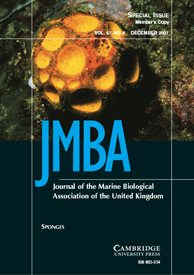Reading DNA labels on sponges
 Sponges are difficult to identify and classify. Many sponges “have a depauperate suite of morphologic characters and/or are plagued by morphological homoplasies” and vary according to environmental conditions, challenging identification at species level and stymying attempts to reconstruct evolutionary lineages. In Dec 2007 J Marine Biol Assoc UK researchers from Geoscience Centre Gottingen, Germany, and Queensland Museum, Australia, report on how DNA can help. Worheide and Erpenbeck describe the nascent Sponge Barcoding Project www.spongebarcoding.org, which aims to collect DNA signature sequences [COI barcodes] from all 8,000 known marine intertidal, deep sea, and freshwater sponge taxa. According to the authors “DNA barcoding will open up a new dimension and quality in biodiversity research and will become of vital importance for the survival and acknowledgement of sponge taxonomy and increase its reputation over the coming decades.” In addition to assisting species-level identifications, the authors posit the necessity of “DNA-assisted” taxonomy of sponges given the inability to construct convincing higher order classifications with morphologic characters.
Sponges are difficult to identify and classify. Many sponges “have a depauperate suite of morphologic characters and/or are plagued by morphological homoplasies” and vary according to environmental conditions, challenging identification at species level and stymying attempts to reconstruct evolutionary lineages. In Dec 2007 J Marine Biol Assoc UK researchers from Geoscience Centre Gottingen, Germany, and Queensland Museum, Australia, report on how DNA can help. Worheide and Erpenbeck describe the nascent Sponge Barcoding Project www.spongebarcoding.org, which aims to collect DNA signature sequences [COI barcodes] from all 8,000 known marine intertidal, deep sea, and freshwater sponge taxa. According to the authors “DNA barcoding will open up a new dimension and quality in biodiversity research and will become of vital importance for the survival and acknowledgement of sponge taxonomy and increase its reputation over the coming decades.” In addition to assisting species-level identifications, the authors posit the necessity of “DNA-assisted” taxonomy of sponges given the inability to construct convincing higher order classifications with morphologic characters.
An accompanying article analyzes COI barcode results for 166 specimens belonging to 65 species of Caribbean sponges. Similar to findings in other animal groups, the 584 bp COI fragment produced a gene tree similar to that with 28s rRNA, a slowly-evolving nuclear gene. In a ML analysis, some species had overlapping or shared sequences, which the authors point out may mean these are not “good species”, specimen identifications are incorrect, or that these species cannot be distinguished by a COI barcode alone. The sequences are published in GenBank and available individually through the Sponge Barcode website, and I hope the authors will also make their sequence and specimen data available on the Published Projects section of BOLD. This will allow access to the analytic and display software on the BOLD site, enable easy comparison of the sponge data set with that of other animals, and facilitate testing of other methods particularly for those species which are not distinguished in ML analysis.
This entry was posted on Wednesday, December 12th, 2007 at 11:26 pm and is filed under General. You can follow any responses to this entry through the RSS 2.0 feed. Both comments and pings are currently closed.
December 13th, 2007 at 4:29 am
It seems that it would be a nice addition to BOLD’s analysis capabilities if researchers could choose to have GenBank and EMBL sequences also included. This could be tagged or marked differently. While it is true that the standards for getting data into BOLD are more strict, data in these other databases are not necessarily substandard. The study to which you refer above also included other markers and it is much easier for researchers to put these data into GenBank or EMBL at once rather than have to go through the process of also submitting part of them to BOLD. (In this case, the COI data are in the Sponge Barcoding Project database which will feed into BOLD I believe, so it really is not much of an issue here.) One of BOLD’s major limitations is the restriction to this single COI marker. As everybody knows, for some groups this marker does not work as well as others for barcoding purposes. Some of us are very much anticipating the day when BOLD readily handles these other types of data.
December 25th, 2007 at 2:11 am
I never new that 28s rRNA was a slowly evolving gene! you learn something new every day…
February 25th, 2008 at 5:49 pm
Hmm I am also surprised about slow evolving gene, not that they exist (I study and searching on it now) but that 28s rRNA was one. I only knew it initiated polypeptide synthesis.